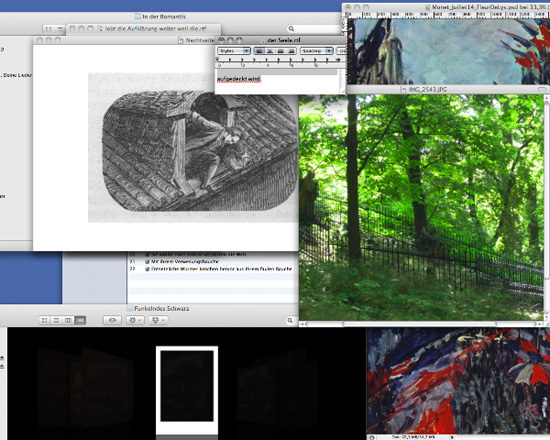Miriam Visaczki “Waldmünchen 1 – 4”, “Ich habe noch nie einen Menschen gesehen”
Shedhalle / Exhibitions / Cross-fades / Artists

Miriam Visaczki “Waldmünchen, 1 – 4”, 2008 (detail)
Waldmünchen 1 – 4
Varnished wood, glass, C-prints, cardboard, 30x45x10cm, 2006
A diagonal area, one part white, one part green, that’s the simplified heraldic emblem of Waldmünchen, a small town in the Bavarian region Upper Palatinate bordering the Czech Republic, and hometown of Miriam Visaczki’s family. Next to the coat of arms, a historic photo from Waldmünchen: the inauguration of the war memorial, in 1908 (Einweihung des Kriegerdenkmals 1908). Miriam Visaczki immersed the photo in red light, cut it, photographed it repeatedly. In a similar way, she fragmented pictures taken a couple of years ago from a punch-up, a fight between locals and guests that had flared up because of racist expressions used – Frühlingsfest Waldmünchen.
The process of cutting something up and putting it together again, refers to collage techniques and challenges the visions of community and the ability to put up a fight, visions the pictures refer to. The mytholology of a people united is set against the dissolving corpus of the picture. Finally, Der Traum vom Widerstand (The Dream of Resistance) unfolds a different picture memory paints and a view of the community. By linking documented history with the present experienced and with dream sequences the artist outlines the longing for a different, possible, hero’s story, one that one could look back on, one that could be inscribed in an imaginary WE of monuments and festivities.

Miriam Visaczki “Ich habe noch nie einen Menschen gesehen”, 2010
The statement “Ich habe noch einen Menschen gesehen” quotes Joseph de Maistre, an opponent of Enlightenment and the French Revolution, and mirrors his opinion that something like a condition humaine does not exist, there are only differences between people. In Miriam Visaczki’s version, this anti-modern statement changes to a sobered-up hopeful statement of post-modern times that the project of the modern and of Enlightenment still has not reached and included everybody, still is awaiting its completion. Just as the quote that’s used as title refers to the contrasting forces of freedom and restoration, the short screenshot animation shortens our 200-year-old history since the French Revolution to a couple of minutes leaving open at which point we stand today.
We see Heinrich Heine, the political and romantic Jewish poet full of his ideals of freedom and poetry, juxtaposed to Friedrich Ludwig Jahn, German inventor of modern gymnastics apparatuses and exercises, whose thinking, in parts at least, was very similar to the national socialist thinking one hundred years later. Miriam Visaczki chose a form of historiography that gives a non-linear and selective tour of the plethora of literary archives. The links are subjective and associative, give a lot of dense information and historical allusions, and have to be elaborately decoded just as we have to decipher an SMS or a file. The work demonstrates – visually, too – not only that a lot is overlapping but that a lot has been written that still is awaiting its fulfillment.
